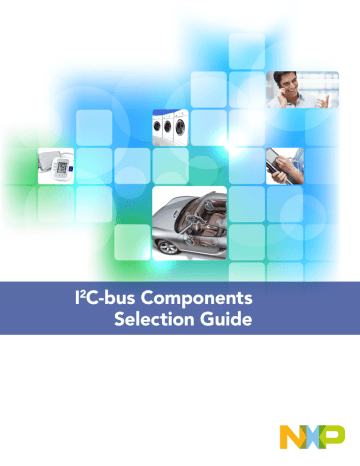- Industrial & lab equipment
- Electrical equipment & supplies
- Circuit protection
- Voltage regulators
- User manual

advertisement

TABLE OF CONTENTS
Overview . . . . . . . . . . . . . . . . 1
I 2 C-bus System Diagram . . . . 2
Output (GPIO) Expanders. . . .3
Voltage Management . . . . . . 6
LCD Display Drivers. . . . . . . . 8
Real Time Clocks . . . . . . . . . 11
Tiny Serial Analog-to-Digital and Digital-to-Analog
Converters . . . . . . . . . . . . . . 12
Multiplexers and Switches...13
Voltage Translators . . . . . . . 15
EEPROMS) . . . . . . . . . . . . . . 18
Motor Controller . . . . . . . . . 20
Bridge Integrated Circuits and Bus Controllers . . . . . . . 21
(LED Controllers) . . . . . . . . . 23
Capacitive Sensors . . . . . . . 25
Demo Boards. . . . . . . . . . . . 27
Resources. . . . . . . . . . . . . . . 28
Contact Information . . . . . . 29
I 2 C-bus Components Selection Guide
Overview
By replacing complex parallel interfaces with a straightforward yet powerful serial structure, the Inter-Integrated Circuit (I 2 C) bus revolutionized chip-to-chip communications. The I 2 C-bus shrinks integrated circuit (IC) footprints by reducing connection count, leading to lower IC costs, which in turn simplifies printed circuit board (PCB) design complexity and reduces system cost. This bus components selection guide provides an overview of NXP’s deep
I 2 C-bus solutions portfolio.
History
As electronic designs grew in complexity, a need developed for an easy and more cost effective way to connect peripheral devices to their controlling microprocessors. To meet this need, Philips
Semiconductors (now NXP Semiconductors) invented a simple bidirectional 2-wire bus. Originally created over thirty years ago for television applications, the I 2 C-bus has since become a de facto industry standard supported by many companies.
I 2 C Features
The I 2 C-bus requires only two lines: a serial data line (SDA) and a serial clock line (SCL). Each device connected to the bus is software addressable by a unique address, and simple master/ slave relationships exist at all times.
Operation
Serial 8-bit bidirectional data transfers occur at up to 100kbit/s in the Standard mode, up to 400kbit/s in Fast-mode (Fm), up to
1Mbit/sec in Fast-mode plus (Fm+), up to 3.4 Mbit/s in high-speed mode (Hs), and up to 5 Mbits/s (unidirectional) in the new Ultra-
Fast-mode (UFm).
I 2 C Applications
Although originally designed to link a small number of devices locally, improvements to bus speed options and the introduction of bus extension devices has allowed the use of the I 2 C-bus to grow from applications such as cell phones and car radios to systems spanning rooms and even buildings.
I 2 C Specification
For the I 2 C-bus specification and user manual, please visit: http://www.nxp.com/documents/user_manual/UM10204.pdf
1
advertisement
* Your assessment is very important for improving the workof artificial intelligence, which forms the content of this project
Related manuals
advertisement
Table of contents
- 2 Overview
- 3 C-bus System Diagram
- 4 Output (GPIO) Expanders
- 7 Voltage Management
- 9 LCD Display Drivers
- 12 Real Time Clocks
- 13 Converters
- 16 Voltage Translators
- 19 EEPROMS)
- 21 Motor Controller
- 22 and Bus Controllers
- 24 (LED Controllers)
- 26 Capacitive Sensors
- 28 Demo Boards
- 29 Resources
- 30 Contact Information